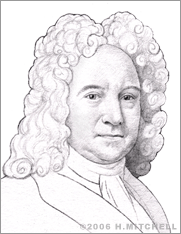Sir Isaac Newton
Isaac Newton was one of an elite group of individuals considered to have possessed one of the greatest scientific minds in history. His achievements span a variety of fields he considered connected, including mathematics, chemistry, optics, and philosophy. His discoveries, which encompass fundamental principles that formed the basis for Calculus, laws of motion, gravitational theory, and theories of color, have clearly stood the test of time.
Born on January 4, 1643 (according to the Gregorian calendar) in Woolsthorpe, Lincolnshire, England, his mother had wanted him to take up farming, but when it became clear to her that his aptitudes lied elsewhere, Newton was sent back to school at age 17 to prepare for university, and he entered Cambridge University’s Trinity College in 1661.
Newton became interested in mechanical philosophy at Cambridge after studying the ideas of philosophers and mathematicians such as Rene Descartes. He sought a fellowship at Cambridge in order to pursue mathematical studies and was elected to a scholarship in 1664 that would guarantee his place there for four years. He was awarded a bachelor’s degree in 1665. However, that year, a plague forced the university to close temporarily, and he returned home to Woolsthorpe. At home in 1666, he began to develop some of his most groundbreaking theories, including the generalized binomial theorem. He later produced three papers that contributed to the formulation of calculus. His achievements in this area, which he hid for a number of years for fear of ridicule, would in time earn him recognition as a mathematical genius.
During his hiatus from Cambridge, Newton also began working on theories of motion that led him to author what is known as the Law of Universal Gravitation. He also developed theories of color after he discovered that white light was actually made up of particles and of various colors. This line of study led him to invent a device that helped to seal his reputation as a scientific visionary: the reflecting telescope.
Newton created the reflecting telescope one year after his return to Cambridge in 1667, the same year he was elected a fellow of the College of the Holy and Undivided Trinity. He received his MA degree in 1668 and remained at Trinity for another 33 years.
Newton experimented with light using a prism. He observed that the spectrum of colors that can be seen when white light passes through a prism is inherent in the white light. He noted that the spectrum was not added by the prism as had been previously believed. He also demonstrated that by using a lens and a second prism, it was possible to reconstruct the rainbow of colored light into white light.
Thus, he began to theorize that telescopes as they existed at the time were limited in terms of resolution by their very design. These refracting telescopes used glass lenses to collect light, and each lens bent different colors of light at slightly different levels, which could cause distortion and limit resolution to the detriment of the viewer. A telescope that used mirrors instead of lenses, he believed, would eliminate this problem, since mirrors reflect all colors of light by the same amount.
Though others had documented ideas for a reflecting telescope in the past, including Scottish scientist James Gregory in 1663, Newton was the first to actually build one. His design used a mirror to collect light and focus it to a second mirror, which would direct the beam of light toward an eyepiece. This, Newton believed, would allow for greater focus even at great magnification, and indeed this was the case. The Newtonian reflecting telescope as it came to be called was much smaller than the refracting telescopes common at the time and magnified over 30 times, despite its six-inch long and one-inch diameter size. Newton demonstrated his device to the Royal Society in 1671.
In connection with this creation, Newton wrote up his theory of colors, which argued that light is composed of particles, and published it in his “Hypothesis of Light” in 1675. He later expanded this into his book, “Opticks.” His body of work in this area became the subject of scrutiny, however, after another optical expert of the time, Robert Hooke, refuted some of Newton’s claims and accused him of plagiarism. Shortly thereafter, Newton gave up optics and took up chemistry. He also began work on a history of religion and produced many writings in this area. In fact, he is said to have spent as much time, if not more, studying religion as science.
In 1679, Newton resumed work in the area of mechanics, including gravity and astronomy, and began laying the groundwork for what later became his seminal work “The Philosophiae Naturalis Principia Mathematica,” or “the Principia,” published in 1687. This tome includes Newton’s three Universal Laws of Motion as well as a formal presentation of his Law of Universal Gravitation.
Newton made a major life change in 1689 and moved to London, where he was elected a Member of Parliament for the University. He chose not to seek re-election in 1690 (though he would serve as an MP again in 1701), but he broadened his social circle in London and was appointed Warden of the London Mint in 1696. He became Master of the Mint in 1699. He was elected President of the Royal Society in 1703, a post that he held for the rest of his life. In 1705, he was knighted by Queen Anne, largely in recognition of his work at the London Mint, where he successfully confronted a currency counterfeiting epidemic and changed the Pound Sterling’s value basis from silver to the gold standard.
In 1709, Newton began work on a second edition of “Principia” and published a second edition of “Opticks.” He died on March 20, 1727 and is buried in Westminster Abbey in London.


